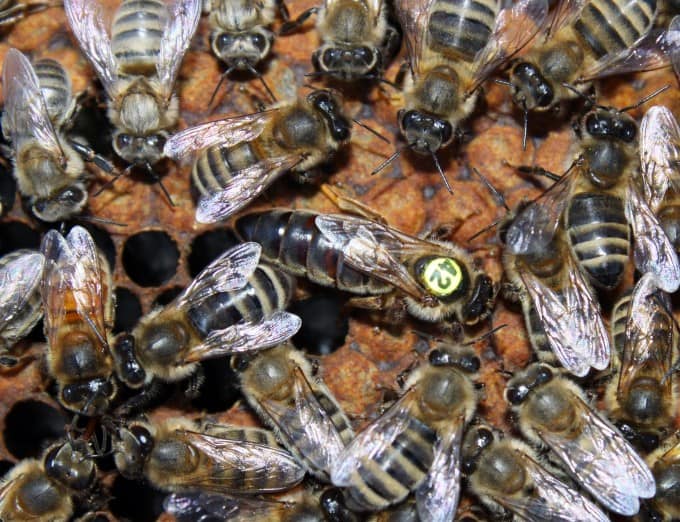The Carniolan bee also known as Apis mellifera carnica or A.m.carnica for short has its origins in Eastern Europe and is therefore adapted to a continental climate with cold hard winters and long hot summers. It is now the main bee in Germany.

Photo from https://beeinformed.org/2012/04/queen-bee-identification/
It is also known as the Grey bee because 3 segments of its abdomen are broadly covered in a thick pelt of short grey hairs which partially conceals the underlying dark abdomen giving it a frosted look. Photo from queen bee identification article on www.beeinformed.org
It is similar to the Italian bee in that it is a medium sized bee with a long narrow body and limbs and it also has the same long proboscis which enables it to make full use of the red clover – an important forage crop in Europe. Here in Ireland, your bees will have to be quick off the mark if you want to get to the clover before that army of sacred cows known as the ‘Dairy Industry’
Coming, as it does, from a region where summers are predictably long and warm, it has a strong swarming tendency. In its native range, winters are long and cold so it does fares better over winter than the Italian bee, being very thrifty with a smaller brood nest. In spring, the build-up can be very rapid indeed an adaptation to take advantage of an early flow. If there is one…
Like all honey bee subspecies in their pure form, Carniolan bees can have a gentle nature which is good. When matings are mixed, aggression can be expected.
Here in the far west of Europe we have our own native bee, the Irish native honey bee, Apis mellifera mellifera, which has evolved over thousands of years and ‘knows’ how to cope with whatever this clammy, wet and unpredictable Irish climate can throw at it.
If you are thinking of importing Carniolan bees – or buying from somebody else who imports Carniolan or any other bees for that matter – remember that you will be helping to erode the genetics of the Irish bee. Ask yourself – why would you want to do that? Wouldn’t you prefer to be a proper beekeeper? Learn to work with your locals and rear your own queens?
Lots of information on that here : Queen Rearing
And don’t forget – small Hive Beetle is out there waiting for somebody just like you. You don’t want to find yourself in front of god explaining why you destroyed your neighbour’s native bee breeding programme and at the same time introduced the most devastating bee parasite to Ireland now do you?
Best not mention you knew what you were doing.
Click here for more on Small Hive Beetle
Click here for more about the Native Irish Bee
Click here for updated list of Irish Native Honey Bee suppliers
Click here for more about the Italian bee
Click here for the Buckfast bee
Copyright © Beespoke.info, 2014. All Rights Reserved.